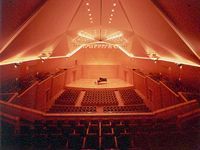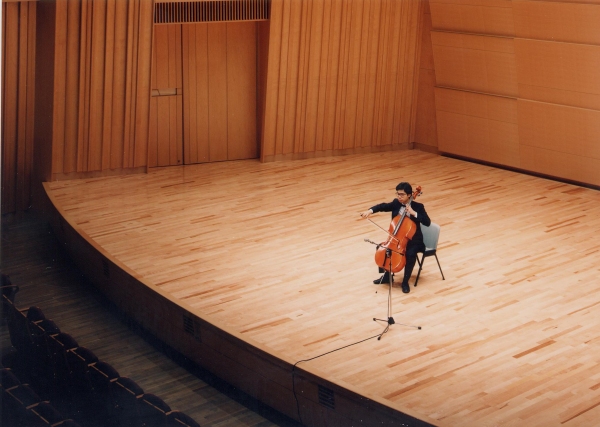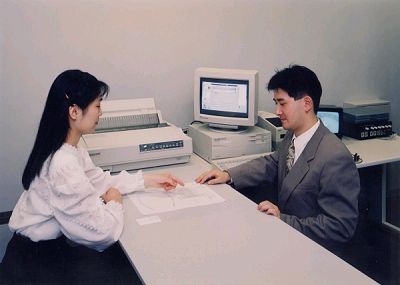
- LL: Sound level
- Dt1: Initial time delay gap
- Tsub: Reverberation time
- IACC: Inter-aural cross-correlation coefficient
Ando also proposed that the concert hall should be designed so as to maximize the subjective preference at each seat.
 |
For the evaluation of sound quality in the concert hall,
Ando (1985) proposed four important acoustic parameters.
Ando also proposed that the concert hall should be designed so as to maximize the subjective preference at each seat. |
 |
Subjective preference of the audience is tested by the listening test
(see Sound Preference Audition
Room) for the acoustic parameters listed above. The important point
here is that listener's sensitivity for each parameter is also
calculated from a preference function in addition to the preference
score. The total preference score is found as a weighted sum of each
score. To calculate a listener's preference score at certain seat, the acoustic properties at that seat should be measured before. Impulse response measurement of the Realtime analyzer enables to measure the acoustic parameters. |
 |
Previous studies found a calculation method of an average preference
value from the acoustic properties of a hall and the type of the music
to be performed there. Now, by this method, the preference score of each
seat can be calculated from the computer simulation in the design stage
of a hall. It is possible to select the form from which the best score
is obtained in the total of the comprehensive preference score of all
seats. Moreover, it is necessary to design so that not only a listener but also conductor and players on a stage may be satisfied. Such research is also progressing. |
 |
Relationship between the music to be performed and the optimal
reverberation time Reverberation time changes the quality of the sound in a room. If the reverberation time is too short, the sound will vanish almost instantaneously. If the reverberation time is too long, on the other hand, echoes will take place. Usually, acoustical engineers design rooms to achieve a typical reverberation time between one and two seconds. However, this standard is a too rough estimation. It is recognized that the optimal reverberation is much dependent on the kind of the music to be performed. For example, performance of the pipe organ needs more than four seconds of the reverberation, whereas two-second reverberation is suitable for the typical orchestra music. On the other hand, such a reverberation time is too long for speech intelligibility. Before the design starts, the purpose of the hall or the kind of performance should be clarified. Next, the physical characteristics of the music should be analyzed. It is found that the property that decides the optimal reverberation time is the reverberation component contained in the sound itself. For example, a sound of a pipe organ contains long reverberation. So the much longer room reverberation is needed to blend with music. On the other hand, speech signal does not contain the reverberation, so the same reverberation time as for music causes undesirable echo. The analysis by the autocorrelation function is effective to characterize such a reverberation component contained in the signal. Optimal reverberation time can be estimated from the effective duration of the autocorrelation function, which is called te. See this page for detail. IACC and spatial impression Another important factor that decide the sound quality in the concert hall is a spatial impression such as a feeling of a spread or a spatial envelopment. Such spatial impressions are largely decided by the inter-aural-cross-correlation (IACC). Psychological experiment revealed that the smaller the value of IACC, the more we get a feeling of a spread for sound field and more preference. To decrease IACC, it is needed to inhibit the strong reflection from the ceiling and to control the angle of the lateral reflection. When the reflection from the sidewall increases, the sound arriving at each ear becomes different. As a result, the sound gives a feeling of a spread in the space. Moreover, in order to make IACC small at the seat of the center of a hall, it is very effective to make a form of the hall asymmetrical. |
 |
It is also important that musicians use a concert hall
correctly in order to improve the quality of their performance.
(1) Select a music suitable for the concert hall. One of the important criteria is te of the music. This parameter represents the length of the reverberation components within the music signal, and can be calculated by means of the running ACF analysis. (2) Select a performance position on the stage that makes musician easy to perform and that improves listeners' preference. |
 |
Even if a hall is designed based on the preference theory,
the sound quality is different for every seat position. For example, at
front seat a sound is loud, but at rear seat a sound becomes weak. Delay
time of the first reflection becomes short near a sidewall.
The listener's preference is different one by one. A listener may sit on an extremely uncongenial seat, if a seat is chosen arbitrary. If a suitable seat can be introduced to every listener, on the contrary, it will become the same as having built the perfect hall for all listeners. That means the variation of the sound quality of a hall can be covered considerably. |